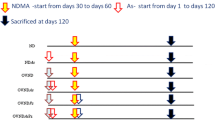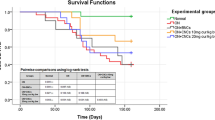Abstract
Cholangiocarcinoma (CCA) associated by Opisthorchis viverrini remains a health problem in Southeast Asia including Thailand. At present, there is still no efficient treatment for CCA. Thunbergia laurifolia is a traditionally used medicinal plant; its aqueous leave extract possesses the antioxidant activity and anti-inflammatory on hamster opisthorchiasis had been reported previously. Here, we demonstrate the combined effects of the T. laurifolia extract plus antihelminthic drug, praziquantel (PZ) on hamsters with opisthorchiasis and hamsters with opisthorchiasis related-cholangiocarcinoma through light microscopic observations of histopathological changes, as well as liver function tests for alanine transaminase (ALT) and alkaline phosphatase, and kidney function tests for blood urea nitrogen and creatinine. Results showed T. laurifolia extract combined with praziquantel reduced inflammatory cell aggregation and inhibiting CCA development, which were correlated to the serum ALT level. These present studies suggest that administration of T. laurifolia after praziquantel treatment clearly improve the hepatobiliary system and could reduce the risk of subsequent CCA development in human.




Similar content being viewed by others
References
Barnett SW (2001) Animal Technology Calculations. In: Barnett SW, Barley J, Francis R, Lane S, Gardner R (eds) Manual of animal technology. Iowa, Oxford, pp 994–1110
Boonjaraspinyo S, Boonmars T, Aromdee C, Kaewsamut B (2010) Effect of finger root on reducing inflammatory cells in hamster infected with Opisthorchis viverrini and N- nitrosodimethylamine administration. Parasitol Res 106(6):1485–1489
Boonmars T, Srisawangwong T, Srirach P, Kaewsamut B, Pinlaor S, Sithithaworn P (2007) Apoptosis-related gene expressions in hamsters re-infected with Opisthorchis viverrini and re-treated with praziquantel. Parasitol Res 102(1):57–62
Boonmars T, Srirach P, Kaewsamut B, Srisawangwong T, Pinlaor S, Pinlaor P, Yongvanit P, Sithithaworn P (2008) Apoptosis-related gene expression in hamster opisthorchiasis post praziquantel treatment. Parasitol Res 102(3):447–455
Boonmars T, Boonjaraspinyo S, Kaewsamut B (2009) Animal models for Opisthorchis viverrini infection. Parasitol Res 104:701–703
Bunnag D, Harinasuta T (1981) Studies on the chemotherapy of human opisthorchiasis: III. Minimum effective dose of praziquantel. Southeast Asian J Trop Med Public Health 2(3):413–417
Bunnag D, Pungpark S, Harinasuta T, Viravan C, Vanijanonta S, Suntharasamai P, Migasena S, Charoenlarp P, Riganti M, Loo Areesuwan S (1984) Opisthorchis viverrini: clinical experience with praziquantel in hospital for tropical diseases. Arzneimittelforschung 34(9B):1173–1174
Chanawirat A (2000) Protective effect of Thunbergia laurifolia extract on ethanol-induced hepatotaxicity in mice. Thesis, Mahidol University, Bangkok, Thailand
Charoensuk L, Pinlaor P, Prakobwong S, Hiraku Y, Laothong U, Ruangjirachuporn W, Yongvanit P, Pinlaor S (2011) Curcumin induces a nuclear factor-erythroid 2-related factor 2-driven response against oxidative and nitrative stress after praziquantel treatment in liver fluke-infected hamsters. Int J Parasitol 41(6):615–626
Chattaviriya P, Morkmek N, Lertprasertsuke N, Ruangyuttikarn W (2010) Drinking Thunbergia laurifolia Lindl. leaf extract helps prevent renal toxicity induced by cadmium in rats. Thai J Toxicol 25(2):124–132
Chivapat S, Chavalittumrong P, Attawish A, Bansiddhi J, Padungpat S (2009) Chronic toxicity of Thunbergia laurifolia Lindl extract. J Thai Tradit Alternat Med 7(1):18–25
Duenngai K, Boonmars T, Sithithaworn J, Sithithaworn P (2013) Diagnosis of early infection and post chemotherapeutic treatment by copro-DNA detection in experimental opisthorchiasis. Parasitol Res 112(1):271–278
Juasook A, Boonmars T, Wu Z, Loilome W, Veteewuthacharn K, Namwat N, Sudsarn P, Wonkchalee O, Sriraj P, Aukkanimart R (2013) Immunosuppressive prednisolone enhances early cholangiocarcinoma in Syrian hamsters with liver fluke infection and administration of N-nitrosodimethylamine. Pathol Oncol Res 19(1):55–62
Khunkitti W, Taweechaisupapong S, Aromdee A, Pese M (2003) Antimicrobial activity of Thunbergia Laurifolia crude extract. The 3rd world congress on medicinal plant and aromatic plants for human welfare, Chiang Mai, Thailand
Oonsivilai R, Ferruzzi MG, Ningsanond S (2008) Antioxidant activity and cytotoxicity of Rang Chuet (Thunbergia laurifolia Lindl.) extracts. As J Food Ag Ind 1(02):116–128
Palipoch S, Jiraungkoorskul W, Tansatit T, Preyavichyapugdee N, Jaikua W, Kosai P (2011) Protective efficiency of Thunbergia laurifolia leaf extract against lead (II) nitrate-induced toxicity in Oreochromis niloticus. J Med Plants Res 5(5):719–728
Pinlaor S, Hiraku Y, Ma N, Yongvanit P, Semba R, Oikawa S, Murata M, Sripa B, Sithithaworn P, Kawanishi S (2004) Mechanism of NO-mediated oxidative and nitrative DNA damage in hamsters infected with Opisthorchis viverrini: a model of inflammation-mediated carcinogenesis. Nitric Oxide 11:175–183
Pinlaor S, Prakobwong S, Hiraku Y, Kaewsamut B, Dechakhamphu S, Boonmars T, Sithithaworn P, Pinlaor P, Ma N, Yongvanit P, Kawanishi S (2008) Oxidative and nitrative stress in Opisthorchis viverrini-infected hamsters: an indirect effect after praziquantel treatment. Am J Trop Med Hyg 78(4):564–573
Pinlaor S, Prakobwong S, Boonmars T, Wongkham C, Pinlaor P, Hiraku Y (2009) Effect of praziquantel treatment on the expression of matrix metalloproteinases in relation to tissue resorption during fibrosis in hamsters with acute and chronic Opisthorchis viverrini infection. Acta Trop 111(2):181–191
Pinlaor S, Prakobwong S, Hiraku Y, Pinlaor P, Laothong U, Yongvanit P (2010) Reduction of periductal fibrosis in liver fluke-infected hamsters after long-term curcumin treatment. Eur J Pharmacol 638(1–3):134–141
Pramyothin P, Chirdchupunsare H, Rungsipipat A, Chaichantipyuth C (2005) Hepatoprotective activity of Thunbergia laurifolia Linn extract in rats treated with ethanol: In vitro and in vivo studies. J Ethnopharmacol 102:408–411
Ruengyutthakan W (1980) The pharmacological studies of Rang Chuet leaves. Thesis, Chiangmai University, Thailand
Srida C, Hankete J, Khunkitti W, Aromdee C, Pese M (2002) Antioxidant activity of Thunbergia Laurifolia ethanolic extract. Thai J Pham Sci 26
Tangpong J, Satarug S (2010) Alleviation of lead poisoning in the brain with aqueous leaf extract of the Thunbergia laurifolia (Linn.). Toxicol Lett 198(1):83–88
Tejasen P, Thongthapp C (1979) The study of the insecticide antitoxicity of Thunbergia laurifolia Linn. Chiang Mai Bull 19:105–114
Thamavit W, Bhamarapravati N, Sahaphong S, Vajrasthira S, Angsubhakorn S (1978) Effects of dimethylnitrosamine on induction of cholangiocarcinoma in Opisthorchis viverrini infected Syrian golden hamsters. Cancer Res 38:634–639
Thongsaard W, Marsden CA (2002) A herbal medicine used in the treatment of addiction mimics the action of amphetamine on in vitro rat strial dopamine release. Neurosci Lett 329(2):129–132
Wonkchalee O, Boonmars T, Aromdee C, Laummaunwai P, Khunkitti W, Vaeteewoottacharn K, Sriraj P, Aukkanimart R, Loilome W, Chamgramol Y, Pairojkul C, Wu Z, Juasook A, Sudsarn P (2012) Anti-inflammatory, antioxidant and hepatoprotective effects of Thunbergia laurifolia Linn on experimental opisthorchiasis. Parasitol Res 111(1):353–359
Acknowledgments
This work was supported by grants from the Thailand Research Fund (grant no. RMU5480002), Khon Kaen University (KKU56) and the Royal Golden Jubilee Ph.D. Program (grant no. PHD/0280/2552) to Miss Nadchanan Wonkchalee and Associate Professor Thidarut Boonmars. We also thank the research affair for giving as an assistant researcher (RA56201), Animal Experimental Unit, Faculty of Medicine, Khon Kaen University for their support.
Author information
Authors and Affiliations
Corresponding author
Rights and permissions
About this article
Cite this article
Wonkchalee, N., Boonmars, T., Laummaunwai, P. et al. A combination of praziquantel and the traditional medicinal plant Thunbergia laurifolia on Opisthorchis viverrini infection and cholangiocarcinoma in a hamster model. Parasitol Res 112, 4211–4219 (2013). https://doi.org/10.1007/s00436-013-3613-y
Received:
Accepted:
Published:
Issue Date:
DOI: https://doi.org/10.1007/s00436-013-3613-y




